The power's out, your cell phone's dead. What do you do? Grab your cordless drill and head to the kitchen, of course. Unroll a few sheets of aluminum, find the mixing beater and a wooden fork, pool together some tape, a ball of yarn and a scrap of 2 x 4, and create yourself a 40-watt hand-crank generator.

The emergency cell phone charger is made from common household items.
Each weekend, Grant Thompson, also known as “The King of Random,” performs his very own risky science experiments, turning everyday items into extraordinary inventions. Earlier this year, he was inspired to create a homemade cell phone charger after watching the Youtube video, “Charge Your Cell Phone With a Flashlight!“
After his Blackberry was out of power, Thompson got to work on his fresh idea. First, he grabbed the phone's USB charger and cut off the USB head, and used wire strippers to remove the outer layer of the cable. He pulled back the shielding on both ends of the cable to reveal the four wires inside, and stripped the plastic from the ends.
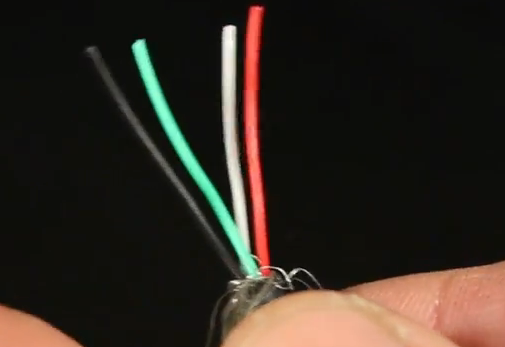
Pull back the shielding on both ends of the cable to reveal the wires.
Most phone batteries need about 5 volts to charge, but Thompson needed to find out for himself. To test this theory, he plugged the phone's USB head into the port on his laptop and attached alligator clips to the exposed red and black wires. Using a multimeter, he saw just over 5 volts of direct current. With the phone in series, the circuit was complete when the wires from both devices touched, and the phone sensed power and lit up.
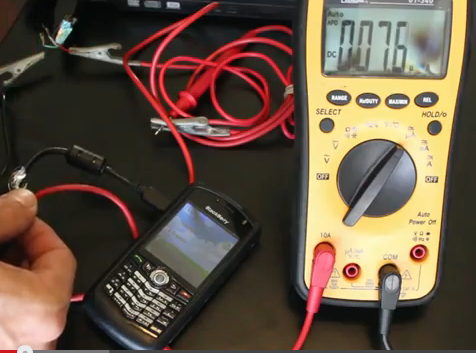
Most cell phones need about 5 volts of current to charge.
With that being a success, Thompson went on to create the makeshift phone charger. He converted his cordless drill into an electric generator by running it backwards. Beforehand, he removed the bit, took the battery out, and for testing, attached alligator clips to the two terminals where the drill's battery connected and attached the leads to his multimeter. When he pulled the trigger and twisted the rotating end of the drill, he generated the needed 5 volts of power.
To make the cordless drill into an emergency cell phone charger, Thompson secured the trigger in the “on” position, since the drill wouldn't work unless it was fully pressed down. He wrapped layers of yarn around the trigger to keep it in place, and to tightly fasten the drill to the piece of 2 x 4. To make sure there was no slack when it was rotated, he inserted a mixing beater into the drill chuck. He also double-checked that the drill was on reverse and set the torque setting at its highest.
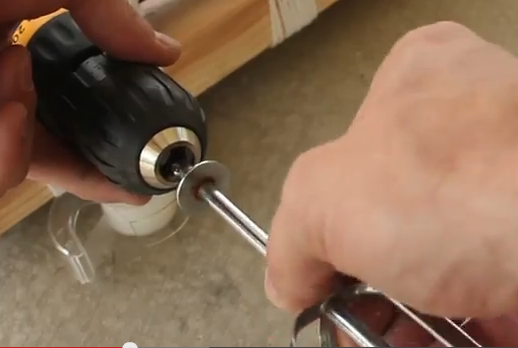
Thompson made sure there was no slack when the drill was rotated.
Creating makeshift wires for the electrical system was simple–Thompson just folded up two strips of aluminum. He suggested that copper would work better, but aluminum wires were perfect conductors to create electricity in a pinch. On each wire, he folded one end to a point and the other flat, so they could be held in place under the terminal clips of the drill. Thompson pointed out that the wires must be separated because they'll short out if they come into contact, so he temporarily taped them down to the 2 x 4 before wrapping them still with strands of yarn. Next, he cut off the green and white wires hanging from the cable, since they were useless, and attached the red and black wires to the aluminum leads with tape. Red served as the positive charge and black was the negative charge.
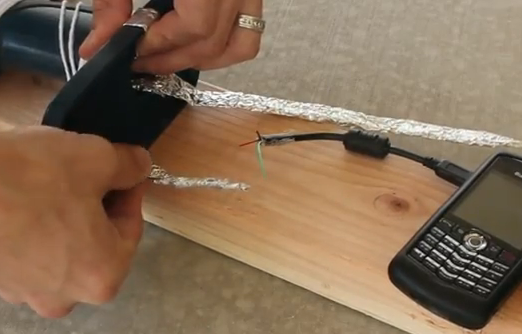
Aluminum wires are perfect to create electricity in a pinch.
The final step was to put together the makeshift handle. Thompson inserted the wooden fork into the mixing beater, began cranking it, and lit the phone up, signaling a charge. Overall, it took him three hours to fully charge his drained Blackberry.
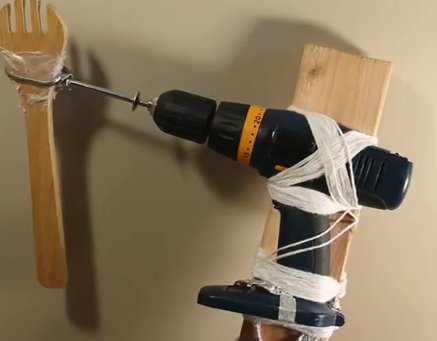
The King of Random's emergency cell phone charger.
Thompson said cranking at a steady rate was important, as going too slowly will cause the charge to go in the opposite direction, draining your battery faster. Since there is no voltage regulated in this kind of system, moving too quickly will generate a higher voltage that can be dangerous to the circuitry of the phone.
After this experiment, Thompson's hand hurt and he finished with some blisters on his finger, but he said he had to do it for the thrill of discovery.
For fully detailed instructions, tune into the King of Random's video, Make an Emergency Phone Charger – MacGyver Style!
To learn about more totally extraordinary projects, visit thekingofrandom.com.
Advertisement
Learn more about Electronic Products Magazine





